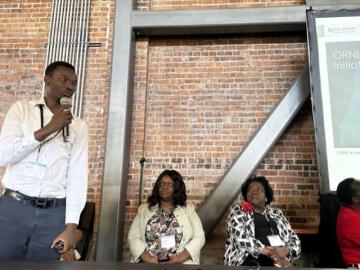
Filter News
Area of Research
- Advanced Manufacturing (2)
- Biology and Environment (36)
- Biology and Soft Matter (1)
- Computational Biology (1)
- Electricity and Smart Grid (1)
- Energy Science (47)
- Fusion and Fission (6)
- Materials (20)
- Materials for Computing (4)
- National Security (17)
- Neutron Science (56)
- Nuclear Science and Technology (5)
- Supercomputing (37)
News Type
News Topics
- (-) Advanced Reactors (12)
- (-) Clean Water (16)
- (-) Composites (11)
- (-) Cybersecurity (14)
- (-) Grid (32)
- (-) High-Performance Computing (81)
- (-) Mathematics (8)
- (-) Neutron Science (82)
- (-) Transportation (30)
- 3-D Printing/Advanced Manufacturing (56)
- Artificial Intelligence (77)
- Big Data (45)
- Bioenergy (68)
- Biology (80)
- Biomedical (42)
- Biotechnology (25)
- Buildings (30)
- Chemical Sciences (35)
- Computer Science (111)
- Coronavirus (19)
- Critical Materials (5)
- Education (2)
- Emergency (3)
- Energy Storage (32)
- Environment (116)
- Exascale Computing (51)
- Fossil Energy (6)
- Frontier (44)
- Fusion (38)
- Hydropower (6)
- Isotopes (33)
- ITER (4)
- Machine Learning (37)
- Materials (51)
- Materials Science (55)
- Mercury (7)
- Microelectronics (3)
- Microscopy (23)
- Molten Salt (2)
- Nanotechnology (17)
- National Security (60)
- Nuclear Energy (66)
- Partnerships (36)
- Physics (34)
- Polymers (9)
- Quantum Computing (35)
- Quantum Science (48)
- Security (16)
- Simulation (42)
- Software (1)
- Space Exploration (13)
- Statistics (2)
- Summit (40)
Media Contacts

National lab collaboration enables faster, safer inspection of nuclear reactor components, materials
A research partnership between two Department of Energy national laboratories has accelerated inspection of additively manufactured nuclear components, and the effort is now expanding to inspect nuclear fuels.
During Hurricanes Helene and Milton, ORNL deployed drone teams and the Mapster platform to gather and share geospatial data, aiding recovery and damage assessments. ORNL's EAGLE-I platform tracked utility outages, helping prioritize recovery efforts. Drone data will train machine learning models for faster damage detection in future disasters.

Scientists conducted a groundbreaking study on the genetic data of over half a million U.S. veterans, using tools from the Oak Ridge National Laboratory to analyze 2,068 traits from the Million Veteran Program.

The US focuses on nuclear nonproliferation, and ORNL plays a key role in this mission. The lab conducts advanced research in uranium science, materials analysis and nuclear forensics to detect illicit nuclear activities. Using cutting-edge tools and operational systems, ORNL supports global efforts to reduce nuclear threats by uncovering the history of nuclear materials and providing solutions for uranium removal.

Maximiliano Ferrari, a researcher in the Grid Systems Architecture group at the Department of Energy’s Oak Ridge National Laboratory, has been elevated to prestigious senior membership in the Institute of Electrical and Electronics Engineers.

The National Center for Computational Sciences, located at the Department of Energy’s Oak Ridge National Laboratory, made a strong showing at computing conferences this fall. Staff from across the center participated in numerous workshops and invited speaking engagements.

A research collaboration between the Department of Energy’s Oak Ridge National Laboratory and several partner institutions was honored with the Best Event Report award at the 2024 International Conference on Game Jams, Hackathons and Game Creation Events.

FREDA is a new tool being developed at ORNL that will accelerate the design and testing of next-generation fusion devices. It is the first tool of its kind to combine plasma and engineering modeling capabilities and utilize high performance computing resources.

The Department of Energy’s Oak Ridge National Laboratory had a major presence at this year’s International Conference for High Performance Computing, Networking, Storage, and Analysis (SC24).



